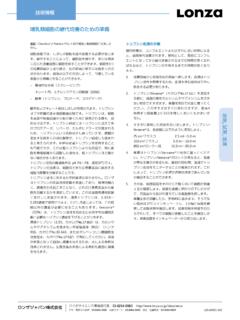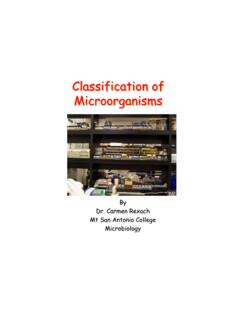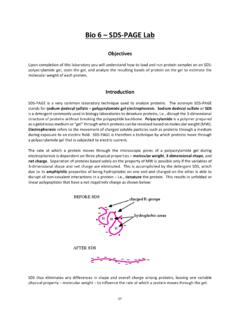Transcription of Appendix A: Electrophoretic Theory
1 203 Electrophoretic TheoryAppendix A: Electrophoretic TheoryIn This SectionVoltage, Current and Power; Interative Effects on Gel electrophoresis 204 Electrophoretic Parameters 2051-800-638-8174 is defined as the movement of ions and charged macromolecules through a medium when an electric current is applied. Agarose and polyacrylamide are the primary stabilizing media used in the electrophoresis of are separated through the matrix based on size, charge distribution and structure. Proteins will separate through the matrix based on size, structure and charge. In general, nucleic acids migrate through a gel based on size, with little influence from base composition or equations are relevant to the use of power supplies for electrophoresis of macromolecules: Ohm s Law and the Second Law of electrophoresis . These two laws and the interactions of these parameters (watts, volts, current) are critical to understanding A: Electrophoretic TheoryVoltage, Current and Power: Interactive Effects on Gel ElectrophoresisOhm s LawCurrent (I)=Voltage (V)/Resistance (R)Ohm s Law states that current is directly proportional to the voltage and is inversely proportional to the resistance.
2 Resistance of the system is determined by the buffers used, the type and configurations of the gels being run, and the total volume of all the gels being LawWatts (W)=Current (I) x Voltage (V)The Second Law states that power or watts (a measure of the heat produced) is equal to the product of the current and voltage. Since V=I x R, this can also be written as Watts=I2 x R. Electrophoretic Theory1-800-638-8174 to Main205 During electrophoresis , one of the parameters is held constant and the other two are allowed to vary as the resistance of the Electrophoretic system changes. In vertical systems, the resistance of the gel increases as highly conductive ions like Cl are electrophoresed out of the gel. As these ions are removed from the gel, the current is carried by less conductive ions like glycine, borate, acetate, etc. Under normal conditions in horizontal systems, there is little change in resistance.
3 However, with high voltage or extended runs in horizontal systems, resistance can are advantages and disadvantages for setting each of the critical parameters as the limiting factor in electrophoresis . Sequencing gels are usually run at constant wattage to maintain a uniform temperature. Agarose and acrylamide gels for protein and DNA separation are run at constant voltage or constant wattageIn a vertical system when wattage is held constant, the velocity of the samples will decrease because the current, which is in part carried by the DNA, decreases to compensate for the increase in voltage. The generation of heat will remain uniform. If the current should decrease disproportionately (from a buffer problem, a buffer leak or a hardware problem), the power supply will increase the voltage to voltage and current vary over time at a constant wattage, it is not possible to predict mobility of samples from the calculation of currentWhen the current is held constant, the samples will migrate at a constant rate.
4 Voltage and wattage will increase as the resistance increases, resulting in an increase in heat generation during the a break occurs in the system, such as a damaged lead or electrode or a buffer leak, the resistance of the gel will be greatly increased. This will cause a large increase in wattage and voltage resulting in the generation of excessive heat. It is even possible for the system to get hot enough to boil, or start the apparatus to scorch or voltageWhen voltage is set constant, current and wattage will decrease as the resistance increases, resulting in a decrease of heat and DNA the heat generated will decrease, the margin of safety will increase over the length of the run. If a problem develops and the resistance increases dramatically, the current and wattage will fall since the voltage cannot increase. Even if the apparatus fails, the worst that is likely to happen is that the resistance will increase so much that the power supply will not be able to compensate, and it will shut A: Electrophoretic TheoryElectrophoretic Parameters20 015 010 050001246 Volts & WattsTi me (hours)VoltsWatt smA3572520151050mA20 015 010 050001246 Volts & WattsTi me (hours)VoltsWatt smA357706050403020100mA20 015 010 050001246 Volts & WattsTi me (hours)VoltsWatt smA3572520151050mAReferenceRickwood, D.
5 And Hames, ,1. Gel electrophoresis of Nucleic Acids: A Practical Approach, IRL Press Limited, TheoryContant wattageConstant currentConstant voltage1-800-638-8174 to Main206 Notes1-800-638-8174 to Mai

















